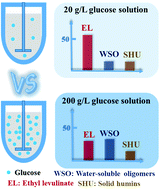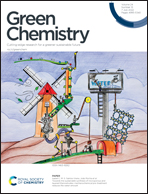Mechanistic insights into the effect of the feed concentration on product formation during acid-catalyzed conversion of glucose in ethanol†
Abstract
Catalytic upgradation of carbohydrates in concentrated feeds well conforms to the demands for the industrial deployment of bio-based fuels and chemicals, but the majority of existing explorations merely focused on the utilization of dilute feedstock. In this contribution, the degradation behavior of both dilute (20 g L−1) and concentrated glucose (200 g L−1) in an ethanol medium was comparatively investigated by acid catalysis. The increase of the glucose concentration from 20 to 200 g L−1 largely boosted the formation of water-soluble oligomers (WSO) instead of solid humins (SHU). The high initial glucose concentration favored the formation of glucose oligomers, and the high instantaneous concentration of EL and 5-hydroxymethylfurfural (HMF) also exacerbated the polymerization reactions, both of which are responsible for the formation of excessive WSO in a concentrated feed. Structural characterization revealed that substituted furans, 2,5-dioxo-6-hydroxyhexanal (DHH) and its analogue are the main fragments in WSO20, while WSO200 largely consisted of glucosyl units as well as furanic and aromatic fragments linked with aliphatic units, leading to the distinct structure of SHU from the two feed concentrations. This work provides insights into the effect of the feed concentration on product formation during acid-catalyzed ethanolysis of glucose, facilitating the development of optimal processes for valorizing concentrated sugars.



 Please wait while we load your content...
Please wait while we load your content...